Family name: Hypoxidaceae R. Brown
Synonym(s): [none]
Common name(s): star-grass family
*Number of genera/species: 4/159
List of genera records in GRIN-Global
fruit or seed
Fruit a circumscissilecircumscissile:
(~pyxis); type of capsular dehiscence, opens by a lid (splitting transversely)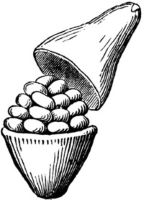 or loculicidalloculicidal:
or loculicidalloculicidal:
type of capsular dehiscence, opening longitudinally through the locules (compare septicidal)
 capsulecapsule:
capsulecapsule:
a dry, dehiscent fruit derived from a compound ovary or berryberry:
or berryberry:
an indehiscent, fleshy fruit with one or a few to many seeds. The flesh may be homogenous throughout. Or, if the outer part is hard, firm, or leathery, referred to as an hesperidium. Septa are present in some, and the seeds may be arillate or with a fleshy testa. (Curculigo), 6–33 mm long, ovoidovoid:
(Curculigo), 6–33 mm long, ovoidovoid:
3D shape—ovate to fusiformfusiform:
to fusiformfusiform:
spindle-shaped; broadest at the middle and tapering at both ends , tereteterete:
, tereteterete:
approximately circular in cross section; width and thickness approximately equal
 or triangulartriangular:
or triangulartriangular:
2D shape—three relatively straight sides with distinct corners; more angular than teardrop-shaped in transection, with many seeds. Fruits with persistent perianthperianth:
in transection, with many seeds. Fruits with persistent perianthperianth:
collective term for calyx and corolla of a flower
 , petalspetal:
, petalspetal:
a member of the inner envelope of a flower (corolla)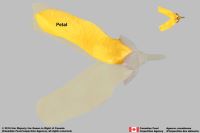 , or bracts and sometimes beakedbeak:
, or bracts and sometimes beakedbeak:
a usually firm, terminal appendage, sometimes tapered (persistent corollacorolla:
(persistent corollacorolla:
the inner whorl(s) of the perianth; all the petals of a flower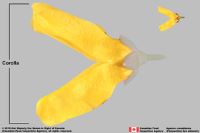 ). Pericarppericarp:
). Pericarppericarp:
fruit wall or fruit coat
white or green, fleshy (berryberry:
an indehiscent, fleshy fruit with one or a few to many seeds. The flesh may be homogenous throughout. Or, if the outer part is hard, firm, or leathery, referred to as an hesperidium. Septa are present in some, and the seeds may be arillate or with a fleshy testa. ) or dry (berryberry:
) or dry (berryberry:
an indehiscent, fleshy fruit with one or a few to many seeds. The flesh may be homogenous throughout. Or, if the outer part is hard, firm, or leathery, referred to as an hesperidium. Septa are present in some, and the seeds may be arillate or with a fleshy testa. or capsulecapsule:
or capsulecapsule:
a dry, dehiscent fruit derived from a compound ovary ), sometimes pubescentpubescent:
), sometimes pubescentpubescent:
surface relief—bearing hairs
.
Seeds globoseglobose:
3D shape—more or less spherical or ovaloval:
or ovaloval:
2D shape—elongate, widest at the middle, and symmetrically convex-attenuate to rounded ends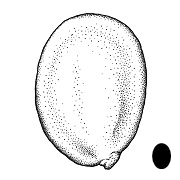 , tereteterete:
, tereteterete:
approximately circular in cross section; width and thickness approximately equal
 in transection, 0.5–6 mm long, each with conspicuous rapheraphe:
in transection, 0.5–6 mm long, each with conspicuous rapheraphe:
a ridge or seam on the seed coat, formed by the portion of the funiculus united to the ovule wall in longitudinally curved ovules and protruding micropylemicropyle:
and protruding micropylemicropyle:
an opening in the integuments of an ovule usually acting as a passage for the pollen tube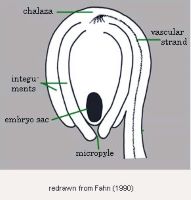 , sometimes funiculifuniculus:
, sometimes funiculifuniculus:
(alt. funicle) stalk connecting the ovule (later seed) to the ovary (later fruit) placenta persistent. Seed coat black or brown, dulldull:
persistent. Seed coat black or brown, dulldull:
reflecting only a low proportion of incident light, with no apparent sheen or shinyshiny:
or shinyshiny:
uniformly reflecting a high proportion of incident light at all angles , thick phytomelanphytomelan:
, thick phytomelanphytomelan:
carbonaceous, opaque material that usually covers the seed coat to give it a black appearance, common in certain monocot families crust, membranousmembranous:
crust, membranousmembranous:
texture—extremely thin, pliable, and fairly tough
, smooth or variously sculptured from spinyspiny:
having slender, stiff, sharp projections oriented in the general plane of the structure to granulargranular:
to granulargranular:
surface relief—having a grainy surface . ElaiosomesElaiosome:
. ElaiosomesElaiosome:
a lipid and protein-rich fleshy structure attached to some seeds and fruits, it attracts ants which then disperse the disseminule (e.g., caruncle in the Euphorbiaceae, the aril (outgrowth of the funiculus) in the Fabaceae)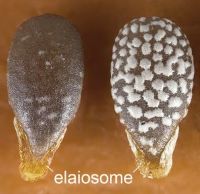 attached to hilahilum:
attached to hilahilum:
on seeds, the scar indicating where the funiculus was attached; on grass caryopses, the scar visible on the outer fruit surface revealing where the seed is attached on the inner fruit wall surface; or in Asteraceae cypselae, the scar visible on the outer fruit wall revealing where the fruit was attached to the receptacle on Curculigo and Empodium seeds.
on Curculigo and Empodium seeds.
Embryo rudimentaryrudimentary:
(of embryo) embryo is small and fills less than a quarter of the seed and can be variable in shapes, such as linear, spatulate, or oval , cylindricalcylindrical:
, cylindricalcylindrical:
3D shape—a cylinder, with parallel sides and a circular cross-section; tubular or rod-shaped
, straight, fills seed coat to 1/2 to 2/3 the length of the seed.
Endosperm copious.
| Fruit | |
| Type | capsulecapsule: a dry, dehiscent fruit derived from a compound ovary  , berryberry: , berryberry:an indehiscent, fleshy fruit with one or a few to many seeds. The flesh may be homogenous throughout. Or, if the outer part is hard, firm, or leathery, referred to as an hesperidium. Septa are present in some, and the seeds may be arillate or with a fleshy testa.  |
| Size range | 6–33 mm long |
| Shape(s) | ellipsoidellipsoid: 3D shape—elliptic , oblongoblong: 2D shape—much longer than broad with nearly parallel sides, corners are rounded  , fusiformfusiform: , fusiformfusiform:spindle-shaped; broadest at the middle and tapering at both ends  , cylindricalcylindrical: , cylindricalcylindrical:3D shape—a cylinder, with parallel sides and a circular cross-section; tubular or rod-shaped , ovoidovoid: 3D shape—ovate  , conicalconical: , conicalconical:3D shape—cone-shaped, with the point of attachment at the broad end  |
| Texture | fleshy (berryberry: an indehiscent, fleshy fruit with one or a few to many seeds. The flesh may be homogenous throughout. Or, if the outer part is hard, firm, or leathery, referred to as an hesperidium. Septa are present in some, and the seeds may be arillate or with a fleshy testa.  ) or dry (capsulecapsule: ) or dry (capsulecapsule:a dry, dehiscent fruit derived from a compound ovary  ) ) |
| Color(s) | white, green |
| Unique features | Usually white or green capsulescapsule: a dry, dehiscent fruit derived from a compound ovary  with persistent perianthperianth: with persistent perianthperianth:collective term for calyx and corolla of a flower  and small globoseglobose: and small globoseglobose:3D shape—more or less spherical  , tereteterete: , tereteterete:approximately circular in cross section; width and thickness approximately equal  , phytomelan-encrusted seeds with conspicuous raphaeraphe: , phytomelan-encrusted seeds with conspicuous raphaeraphe:a ridge or seam on the seed coat, formed by the portion of the funiculus united to the ovule wall in longitudinally curved ovules  . Sometimes a berryberry: . Sometimes a berryberry:an indehiscent, fleshy fruit with one or a few to many seeds. The flesh may be homogenous throughout. Or, if the outer part is hard, firm, or leathery, referred to as an hesperidium. Septa are present in some, and the seeds may be arillate or with a fleshy testa.  . . |
| Seed | |
| Size range | 0.6–5 mm long |
| Shape(s) | globoseglobose: 3D shape—more or less spherical  , ellipsoidellipsoid: , ellipsoidellipsoid:3D shape—elliptic |
| Surface relief | smooth, spinyspiny: having slender, stiff, sharp projections oriented in the general plane of the structure  , papillatepapillate: , papillatepapillate:surface relief—bearing minute, distinct, broad-based projections, tapering to a rounded apex  , granulargranular: , granulargranular:surface relief—having a grainy surface  , colliculatecolliculate: , colliculatecolliculate:surface relief—covered with small, round projections, similar to blistered  , wrinkledwrinkled: , wrinkledwrinkled:surface relief—shallow, irregular folds and furrows covering the surface; appearing overall though crumpled and then spread out  , striatestriate: , striatestriate:surface relief—having fine, parallel lines, grooves or ridges  |
| Color(s) | black, brown |
| Unique features | Globoseglobose: 3D shape—more or less spherical  seeds with thick layer of phytomelanphytomelan: seeds with thick layer of phytomelanphytomelan:carbonaceous, opaque material that usually covers the seed coat to give it a black appearance, common in certain monocot families  crust, conspicuous raphaeraphe: crust, conspicuous raphaeraphe:a ridge or seam on the seed coat, formed by the portion of the funiculus united to the ovule wall in longitudinally curved ovules  , and sculptured. , and sculptured. |
| Other | |
| Embryo | rudimentaryrudimentary: (of embryo) embryo is small and fills less than a quarter of the seed and can be variable in shapes, such as linear, spatulate, or oval  , cylindricalcylindrical: , cylindricalcylindrical:3D shape—a cylinder, with parallel sides and a circular cross-section; tubular or rod-shaped , straight, fills seed coat to 1/2 to 2/3 the length of the seed |
| Nutritive tissue | endosperm copious |
Pantropical.
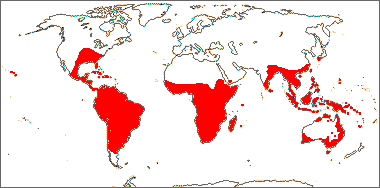
Distribution map courtesy of Angiosperm Phylogeny Website.
Baskin and Baskin 2021Baskin and Baskin 2021:
Baskin C and Baskin J. 2021. Relationship of the lateral embryo (in grasses) to other monocot embryos: A status up-grade. Seed Science Research 31 (3): 199-210. doi:10.1017/S0960258521000209; Berryberry:
an indehiscent, fleshy fruit with one or a few to many seeds. The flesh may be homogenous throughout. Or, if the outer part is hard, firm, or leathery, referred to as an hesperidium. Septa are present in some, and the seeds may be arillate or with a fleshy testa. et al. 1995; Dahlgren et al. 1985Dahlgren et al. 1985:
et al. 1995; Dahlgren et al. 1985Dahlgren et al. 1985:
Dahlgren RMT, Clifford HT, and Yeo PF. 1985. The families of the monocotyledons: structure, evolution, and taxonomy. Springer-Verlag, Berlin. 520 pp.; Davidse et al. 2009–2018Davidse et al. 2009–2018:
Davidse GM, Sousa Sánchez M, Knapp S. and Chiang Cabrera F, eds. 2009–2018. Flora Mesoamericana. Missouri Botanical Garden, St. Louis, MO. Accessed: January–April 2024. URL: http://legacy.tropicos.org/Project/FM; Nooteboom et al. 2021+Nooteboom et al. 2021+:
Nooteboom HP, de Wilde WJJO, Stevens PF, Coode MJE, and Saw LG. 2021+ Flora Malesiana Online. Accessed January 2021–March 2024. URL: https://portal.cybertaxonomy.org/flora-malesiana/; Flora of Australia 2021+Flora of Australia 2021+:
Flora of Australia. Australian Biological Resources Study, Canberra. Accessed January 2021–March 2024. URL: http://www.ausflora.org.au; Kirkbride et al. 2006Kirkbride et al. 2006:
Kirkbride JH, Jr, Gunn CR, and Dallwitz MJ. 2006. Family guide for fruits and seeds, vers. 1.0. Accessed September 2020-January 2022. URL: https://nt.ars-grin.gov/seedsfruits/keys/frsdfam/index.cfm .; Kubitzki et al. 1990+Kubitzki et al. 1990+:
Kubitzki K et al., eds. 1990+. The families and genera of vascular plants. 7+ vols. Berlin etc.; Stevens 2001+Stevens 2001+:
Stevens PF. 2001+. Angiosperm Phylogeny Website Version 14, July 2017 [and more or less continuously updated since]. Accessed September 2020-2022. URL: http://www.mobot.org/MOBOT/research/APweb/; Stevenson and Loconte 1995Stevenson and Loconte 1995:
Stevenson DW and Loconte H. 1995. A cladistic analysis of monocot families. In: Rudall PJ, Cribb PJ, Cutler DF, and Humphries CJ, eds. Monocotyledons: Systematics and Evolution. Royal Botanic Gardens, Kew.; Takhtajan 2009Takhtajan 2009:
Takhtajan A. 2009. Flowering plants: Second edition. Springer Nature, Switzerland. 871 pp.; Watson and Dallwitz 1992+Watson and Dallwitz 1992+:
Watson L and Dallwitz MJ. 1992+. The families of flowering plants: descriptions, illustrations, identification, and information retrieval. Version: 6th Accessed September 2020-September 2022. URL: delta-intkey.com; Wiland-Szymańska and Nordal 2006Wiland-Szymańska and Nordal 2006:
Wiland-Szymańska J and Nordal I. 2006. Hypoxidaceae. In: Beentje HJ and Ghazangar SA, eds. Flora of Tropical East Africa. Vol 88. Royal Botanic Gardens, Kew, London UK. 25 pp.; Zimudzi et al. 2006Zimudzi et al. 2006:
Zimudzi C, Archer RH, Kwembeya EG, and Nordal I. 2006. Synopsis of Amaryllidaceae from the Flora Zambesica Area. Kirkia 18 (2): 151-168. https://www.jstor.org/stable/23502325
*The number of genera and species is based on Christenhusz and Byng 2016Christenhusz and Byng 2016:
Christenhusz MJM and Byng JW. 2016. The number of known plant species in the world and its annual increase. Phytotaxa 261 (3): 201-217. https://doi.org/10.11646/phytotaxa.261.3.1, which may differ from the number of genera in GRIN-Global.